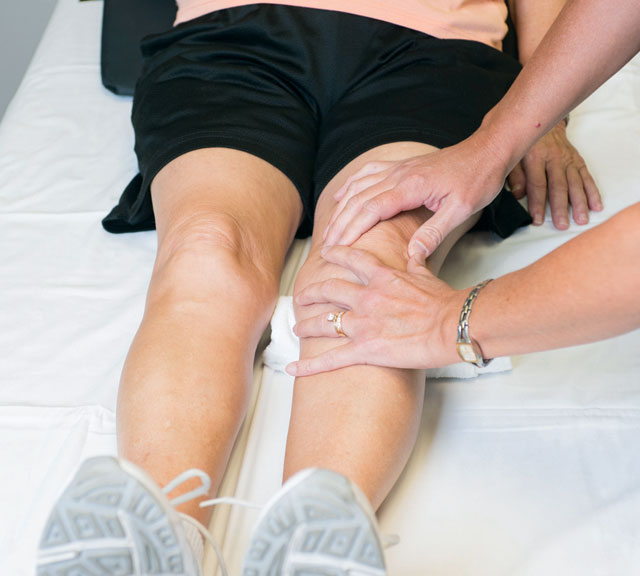- Bone and Joint Health
- Fitness and Exercise
- Health Topics
- Hip Arthritis
- Joint Conditions/Injuries/Treatment
- Joint Pain/Pain Management
- Knee Pain
What a Pain In the Knee (and Hip)! IT Band Syndrome

Find Your Perfect Match
Answer a few questions and we'll provide you with a list of primary care providers that best fit your needs.
Sometimes, in our quest to stay healthy through exercise or to excel at a sport, we can push ourselves too far, and injury or chronic pain can result.
IT band syndrome — pain on the outside of the knee or hip — is an example of just such a problem. People who suffer from IT band syndrome are often involved in long-distance running. But it can also strike those who engage in other athletic activities, such as skiing and cycling, or simply exercising.
The IT (iliotibial) band is a thick cord of fascia, similar to a tendon, that runs along the outer thigh from your ilium (hip bone) to the top of your tibia (one of the two major bones in your lower leg). Orthopedic sports medicine specialist Jeffrey James, DO, explains that the IT band “essentially stabilizes the outer portion of the hip and the knee. It acts as a supporting, connective tissue and provides the power to lift your leg, to swing your leg outward, and to rotate your hip outward.” It's an elastic tissue that acts something like a spring and may serve to help make running more energy efficient.
Many patients respond well to these treatments and can eventually get back to the activities they enjoy.
The Symptoms Of IT Band Syndrome
Each time you bend and straighten your leg, the IT band rubs across the bone on the outside of your knee. Over time, that rubbing can lead to irritation of the band and other tissues in the area (nearby bones, tendons, and small fluid-filled sacs called bursa) resulting in the pain that's familiar to sufferers of IT band syndrome.
“It’s possible to get an acute rupture or tear of the IT band,” says Dr. James, “but most of the time when it’s injured, it’s related to overuse.” While the condition is most common among distance runners, Dr. James has also treated cyclists, and soccer and basketball players.
“Some people have a snapping iliotibial band that snaps in front of and behind the outside of their hip bone,” says Dr. James. “They’ll complain of a snapping sensation, or a clicking, or they feel like their hip is giving out because it’s popping on the outside when they put their leg in certain positions.”
But the most common symptom is pain, described as a burning, aching sensation that can spread from the knee all the way up into the hip. Sometimes it's noticeable only when you're exercising, but as the condition gets worse, the pain can continue well after the exercise has stopped. It can also be made worse by running downhill or by walking up and down stairs. Even sitting with your knees bent for long periods of time can bring on the pain.
How IT Band Syndrome Is Diagnosed
In most instances, IT band syndrome is diagnosed by a physical exam. “We have specific maneuvers – pushing and stretching the IT band to reproduce the pain. Or we’ll bend your knee or hip back and forth to reproduce the snapping,” Dr. James explains. Since the symptoms of IT band syndrome can be similar to those of other conditions (including arthritis), it may be necessary for your doctor to request further diagnostic tests, including an X-ray, ultrasound, or MRI scan.
Treating IT Band Syndrome

There are two main goals in the treatment of IT band syndrome:
- Reducing the pain and inflammation: This is often managed with the use of ice packs, anti-inflammatory and pain-management medications, massage, and rest. In some cases, doctors will give a cortisone shot to help reduce the pain and swelling.
- Using rehabilitation techniques to help keep the problem from coming back: These can include stretching and strengthening exercises to help the IT band and nearby muscles remain limber and to increase the strength of muscles in the hip that can help keep the IT band from rubbing so aggressively against the bone at the knee. Your doctor may recommend that you see a physical therapist to help you learn the proper exercise routines so that you can heal as quickly as possible.
Many patients respond well to these treatments and can eventually get back to the activities they enjoy. If medicine and therapy don’t work, doctors might recommend surgery to alter or remove part of the IT band or nearby tissues.
What Can You Do?
Since IT band syndrome can arise due to habits that you develop over time, you may be able to help your knee and hip (or prevent potential future IT band problems) by changing those habits. You may benefit from consulting with a qualified trainer or sports medicine specialist who can help identify and correct any errors or potential trouble spots in your training regimen. Some common advice includes:
- Don't overtrain. Stick to reasonable distances, and don't increase your mileage too quickly. The general rule of thumb is to increase by 10 percent of your total miles per week.
- Avoid running across sloped surfaces or downhill for long periods. “If you run on the road, be aware that the road is slightly banked,” says Dr. James. “So if you always run in the same direction, one side of your body will be a little higher than the other. That added pressure on one side can lead to IT band syndrome.” And running a lot of hills can put your knees in a more bent position, which can also contribute to IT band syndrome, he adds.
- Don't run on worn-out shoes. Replace them every 300 to 500 miles. Pay special attention to the midsole, the part of the shoe that sits between the upper and the outsole and provides protection from impact forces. It’s the section most likely to break down and lead to injury.
- Take a day or two per week to cross-train. For instance, cycling, swimming, or the elliptical trainer to help prevent injury
- Warm your knee before running by doing both dynamic and static stretches and rolling the IT band. If you’re in pain afterwards, apply ice to the knee.
- Use kinesiology tape. Widely available, this tape works for some people with symptoms.
- Orthotics can sometimes relieve the pain.
If your running or exercise routine continues to cause pain, you may need to consider shortening your distances or even switching to a different form of exercise.
How Long Does It Take To Heal?
“It depends on the severity,” says Dr. James, “but usually the pain calms down in a week or two. Sometimes the tightness and the underlying cause of the pain can take months to truly resolve. And it can recur from time to time.”
The good news is that it’s usually very safe to continue exercising with IT band syndrome. “It completely depends on your level of pain. If it’s severe enough that it’s causing you to limp or you have to completely change your mechanics, it’s best to take a break,” Dr. James explains. “But if it’s just mild discomfort and you’ve seen your doctor, it’s usually safe to continue exercising to some degree while you’re doing treatment. But ask your doctor to be sure.”
Find Your Perfect Match
Answer a few questions and we'll provide you with a list of primary care providers that best fit your needs.
Source: Harvard Gazette; Jeffrey James, DO, Premier Orthopedics; Medline Plus; Sports Injury Clinic; American Family Physician




